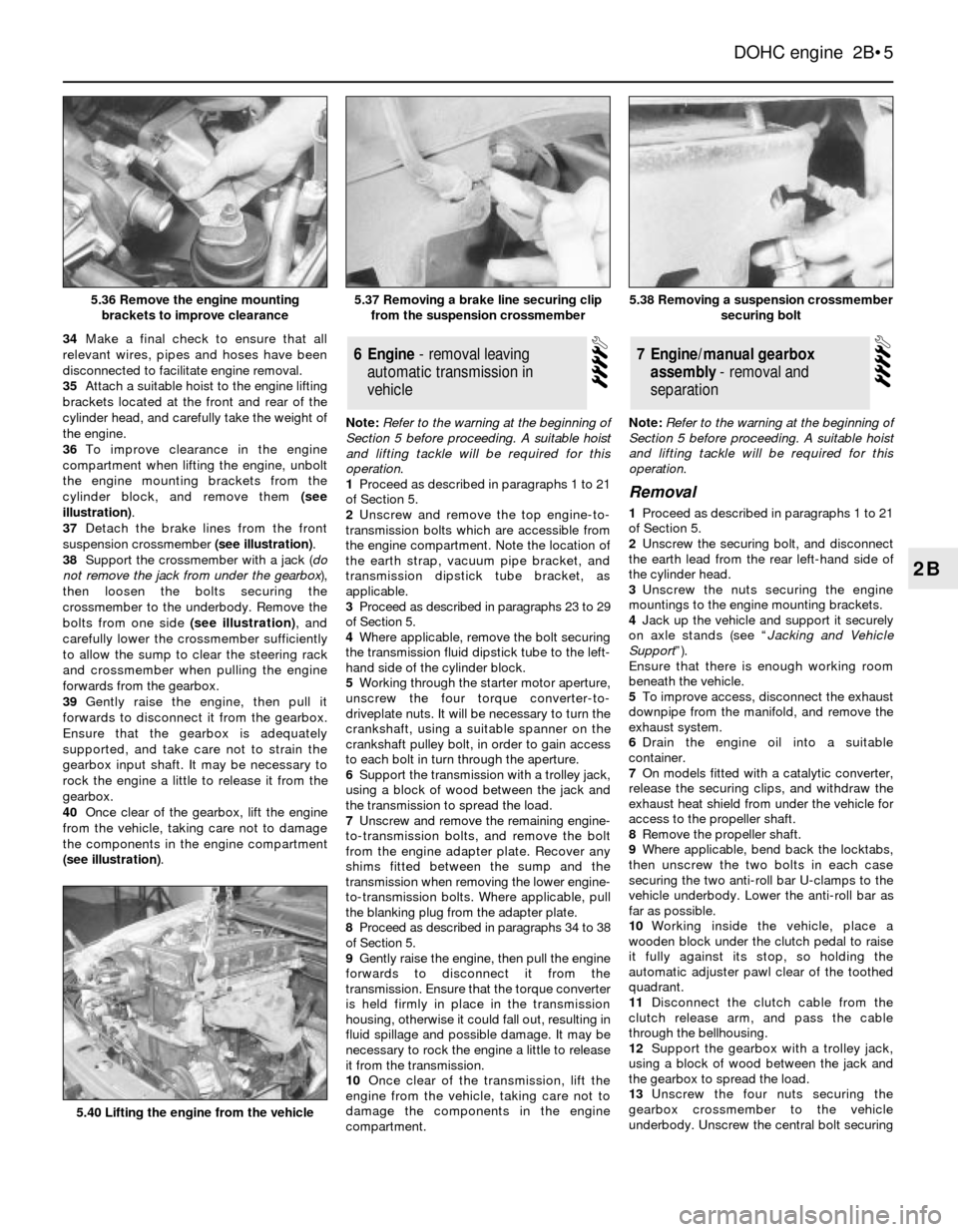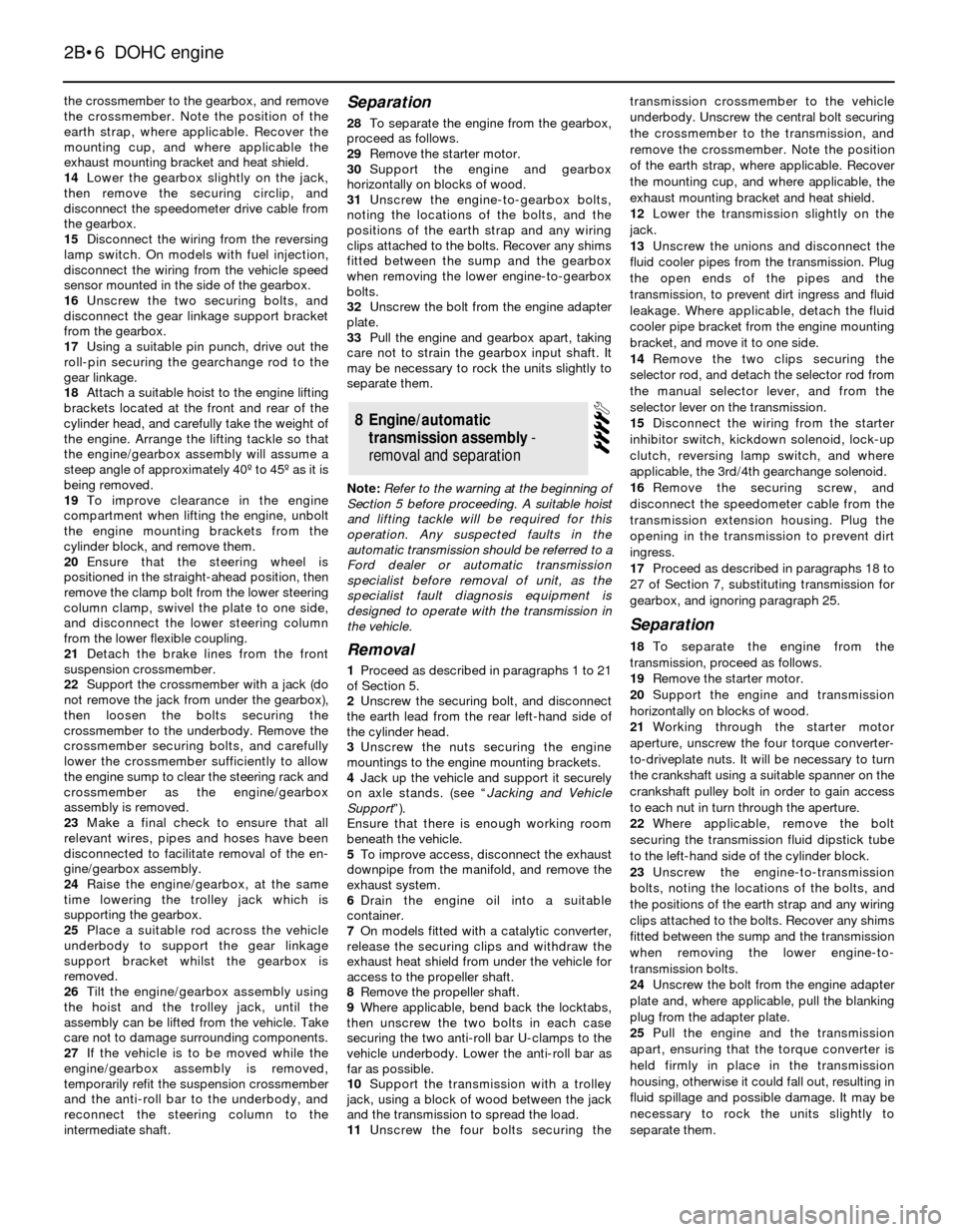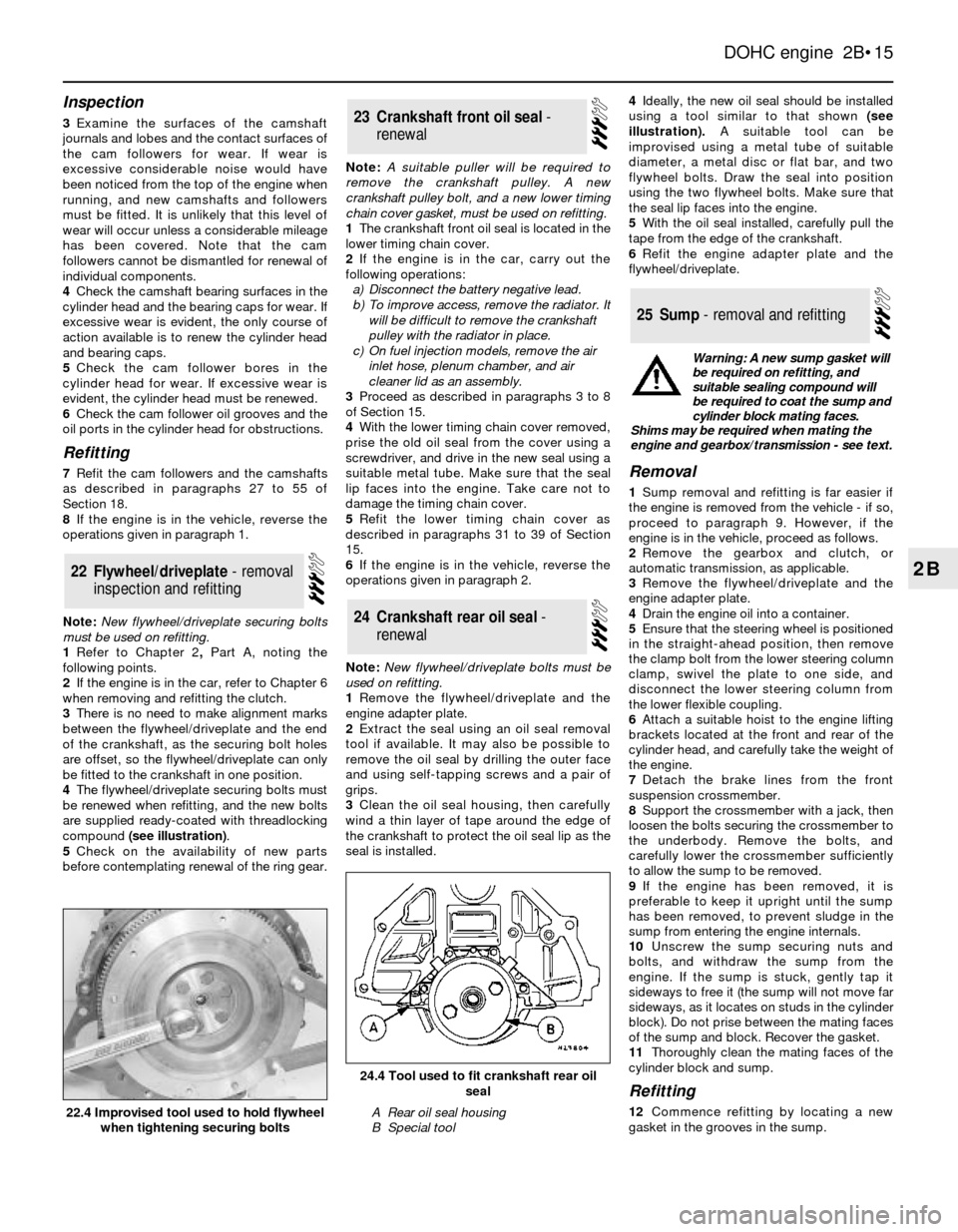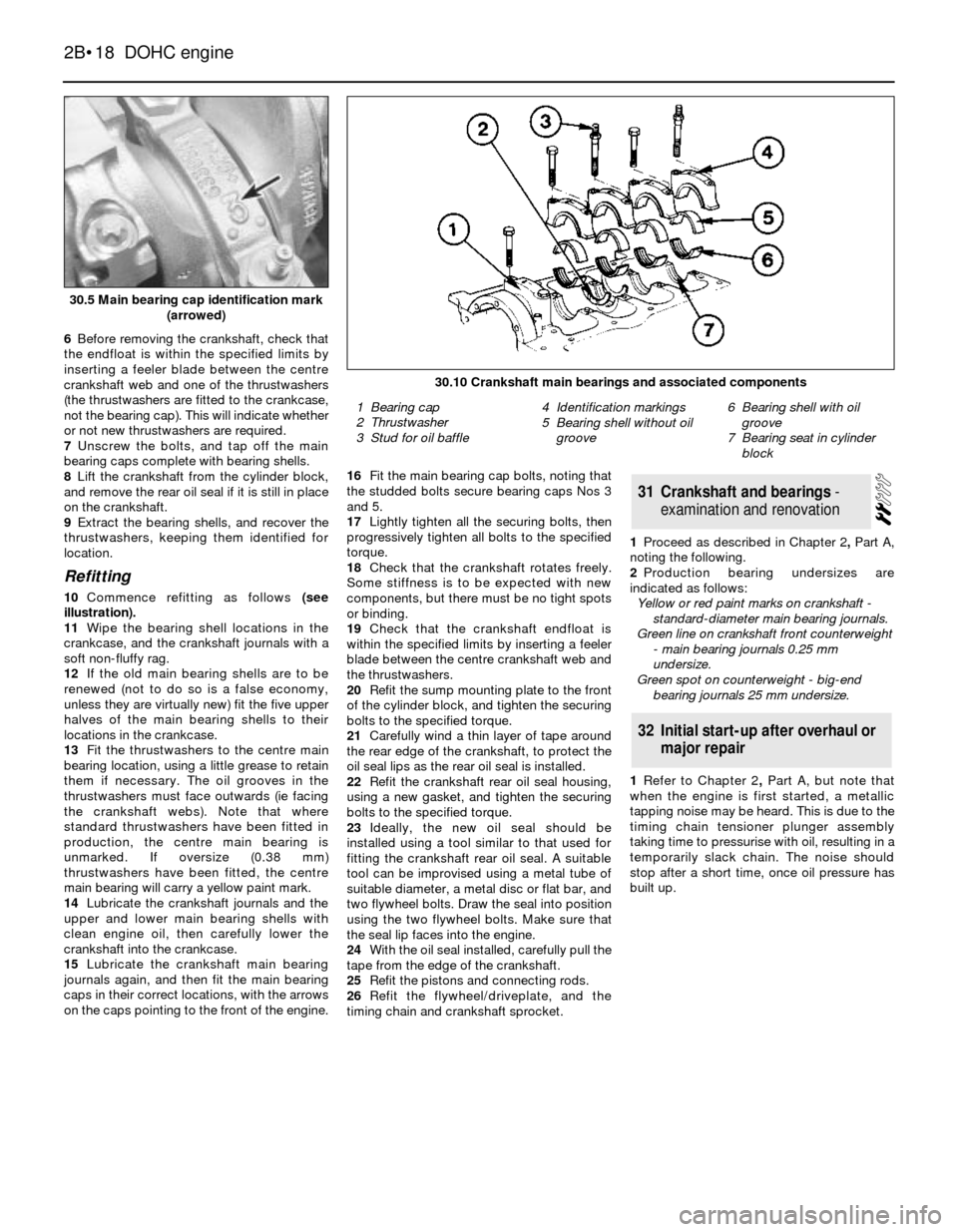weight FORD SIERRA 1982 1.G DOHC Engine Workshop Manual
[x] Cancel search | Manufacturer: FORD, Model Year: 1982, Model line: SIERRA, Model: FORD SIERRA 1982 1.GPages: 18, PDF Size: 0.9 MB
Page 5 of 18

34Make a final check to ensure that all
relevant wires, pipes and hoses have been
disconnected to facilitate engine removal.
35Attach a suitable hoist to the engine lifting
brackets located at the front and rear of the
cylinder head, and carefully take the weight of
the engine.
36To improve clearance in the engine
compartment when lifting the engine, unbolt
the engine mounting brackets from the
cylinder block, and remove them (see
illustration).
37Detach the brake lines from the front
suspension crossmember (see illustration).
38Support the crossmember with a jack (do
not remove the jack from under the gearbox),
then loosen the bolts securing the
crossmember to the underbody. Remove the
bolts from one side (see illustration), and
carefully lower the crossmember sufficiently
to allow the sump to clear the steering rack
and crossmember when pulling the engine
forwards from the gearbox.
39Gently raise the engine, then pull it
forwards to disconnect it from the gearbox.
Ensure that the gearbox is adequately
supported, and take care not to strain the
gearbox input shaft. It may be necessary to
rock the engine a little to release it from the
gearbox.
40Once clear of the gearbox, lift the engine
from the vehicle, taking care not to damage
the components in the engine compartment
(see illustration).Note: Refer to the warning at the beginning of
Section 5 before proceeding. A suitable hoist
and lifting tackle will be required for this
operation.
1Proceed as described in paragraphs 1 to 21
of Section 5.
2Unscrew and remove the top engine-to-
transmission bolts which are accessible from
the engine compartment. Note the location of
the earth strap, vacuum pipe bracket, and
transmission dipstick tube bracket, as
applicable.
3Proceed as described in paragraphs 23 to 29
of Section 5.
4Where applicable, remove the bolt securing
the transmission fluid dipstick tube to the left-
hand side of the cylinder block.
5Working through the starter motor aperture,
unscrew the four torque converter-to-
driveplate nuts. It will be necessary to turn the
crankshaft, using a suitable spanner on the
crankshaft pulley bolt, in order to gain access
to each bolt in turn through the aperture.
6Support the transmission with a trolley jack,
using a block of wood between the jack and
the transmission to spread the load.
7Unscrew and remove the remaining engine-
to-transmission bolts, and remove the bolt
from the engine adapter plate. Recover any
shims fitted between the sump and the
transmission when removing the lower engine-
to-transmission bolts. Where applicable, pull
the blanking plug from the adapter plate.
8Proceed as described in paragraphs 34 to 38
of Section 5.
9Gently raise the engine, then pull the engine
forwards to disconnect it from the
transmission. Ensure that the torque converter
is held firmly in place in the transmission
housing, otherwise it could fall out, resulting in
fluid spillage and possible damage. It may be
necessary to rock the engine a little to release
it from the transmission.
10Once clear of the transmission, lift the
engine from the vehicle, taking care not to
damage the components in the engine
compartment.Note: Refer to the warning at the beginning of
Section 5 before proceeding. A suitable hoist
and lifting tackle will be required for this
operation.
Removal
1Proceed as described in paragraphs 1 to 21
of Section 5.
2Unscrew the securing bolt, and disconnect
the earth lead from the rear left-hand side of
the cylinder head.
3Unscrew the nuts securing the engine
mountings to the engine mounting brackets.
4Jack up the vehicle and support it securely
on axle stands (see “Jacking and Vehicle
Support”).
Ensure that there is enough working room
beneath the vehicle.
5To improve access, disconnect the exhaust
downpipe from the manifold, and remove the
exhaust system.
6Drain the engine oil into a suitable
container.
7On models fitted with a catalytic converter,
release the securing clips, and withdraw the
exhaust heat shield from under the vehicle for
access to the propeller shaft.
8Remove the propeller shaft.
9Where applicable, bend back the locktabs,
then unscrew the two bolts in each case
securing the two anti-roll bar U-clamps to the
vehicle underbody. Lower the anti-roll bar as
far as possible.
10Working inside the vehicle, place a
wooden block under the clutch pedal to raise
it fully against its stop, so holding the
automatic adjuster pawl clear of the toothed
quadrant.
11Disconnect the clutch cable from the
clutch release arm, and pass the cable
through the bellhousing.
12Support the gearbox with a trolley jack,
using a block of wood between the jack and
the gearbox to spread the load.
13Unscrew the four nuts securing the
gearbox crossmember to the vehicle
underbody. Unscrew the central bolt securing
7Engine/manual gearbox
assembly - removal and
separation6Engine - removal leaving
automatic transmission in
vehicle
DOHC engine 2B•5
2B
5.38 Removing a suspension crossmember
securing bolt
5.40 Lifting the engine from the vehicle
5.37 Removing a brake line securing clip
from the suspension crossmember5.36 Remove the engine mounting
brackets to improve clearance
Page 6 of 18

the crossmember to the gearbox, and remove
the crossmember. Note the position of the
earth strap, where applicable. Recover the
mounting cup, and where applicable the
exhaust mounting bracket and heat shield.
14Lower the gearbox slightly on the jack,
then remove the securing circlip, and
disconnect the speedometer drive cable from
the gearbox.
15Disconnect the wiring from the reversing
lamp switch. On models with fuel injection,
disconnect the wiring from the vehicle speed
sensor mounted in the side of the gearbox.
16Unscrew the two securing bolts, and
disconnect the gear linkage support bracket
from the gearbox.
17Using a suitable pin punch, drive out the
roll-pin securing the gearchange rod to the
gear linkage.
18Attach a suitable hoist to the engine lifting
brackets located at the front and rear of the
cylinder head, and carefully take the weight of
the engine. Arrange the lifting tackle so that
the engine/gearbox assembly will assume a
steep angle of approximately 40º to 45º as it is
being removed.
19To improve clearance in the engine
compartment when lifting the engine, unbolt
the engine mounting brackets from the
cylinder block, and remove them.
20Ensure that the steering wheel is
positioned in the straight-ahead position, then
remove the clamp bolt from the lower steering
column clamp, swivel the plate to one side,
and disconnect the lower steering column
from the lower flexible coupling.
21Detach the brake lines from the front
suspension crossmember.
22Support the crossmember with a jack (do
not remove the jack from under the gearbox),
then loosen the bolts securing the
crossmember to the underbody. Remove the
crossmember securing bolts, and carefully
lower the crossmember sufficiently to allow
the engine sump to clear the steering rack and
crossmember as the engine/gearbox
assembly is removed.
23Make a final check to ensure that all
relevant wires, pipes and hoses have been
disconnected to facilitate removal of the en-
gine/gearbox assembly.
24Raise the engine/gearbox, at the same
time lowering the trolley jack which is
supporting the gearbox.
25Place a suitable rod across the vehicle
underbody to support the gear linkage
support bracket whilst the gearbox is
removed.
26Tilt the engine/gearbox assembly using
the hoist and the trolley jack, until the
assembly can be lifted from the vehicle. Take
care not to damage surrounding components.
27If the vehicle is to be moved while the
engine/gearbox assembly is removed,
temporarily refit the suspension crossmember
and the anti-roll bar to the underbody, and
reconnect the steering column to the
intermediate shaft.Separation
28To separate the engine from the gearbox,
proceed as follows.
29Remove the starter motor.
30Support the engine and gearbox
horizontally on blocks of wood.
31Unscrew the engine-to-gearbox bolts,
noting the locations of the bolts, and the
positions of the earth strap and any wiring
clips attached to the bolts. Recover any shims
fitted between the sump and the gearbox
when removing the lower engine-to-gearbox
bolts.
32Unscrew the bolt from the engine adapter
plate.
33Pull the engine and gearbox apart, taking
care not to strain the gearbox input shaft. It
may be necessary to rock the units slightly to
separate them.
Note: Refer to the warning at the beginning of
Section 5 before proceeding. A suitable hoist
and lifting tackle will be required for this
operation. Any suspected faults in the
automatic transmission should be referred to a
Ford dealer or automatic transmission
specialist before removal of unit, as the
specialist fault diagnosis equipment is
designed to operate with the transmission in
the vehicle.
Removal
1Proceed as described in paragraphs 1 to 21
of Section 5.
2Unscrew the securing bolt, and disconnect
the earth lead from the rear left-hand side of
the cylinder head.
3Unscrew the nuts securing the engine
mountings to the engine mounting brackets.
4Jack up the vehicle and support it securely
on axle stands. (see “Jacking and Vehicle
Support”).
Ensure that there is enough working room
beneath the vehicle.
5To improve access, disconnect the exhaust
downpipe from the manifold, and remove the
exhaust system.
6Drain the engine oil into a suitable
container.
7On models fitted with a catalytic converter,
release the securing clips and withdraw the
exhaust heat shield from under the vehicle for
access to the propeller shaft.
8Remove the propeller shaft.
9Where applicable, bend back the locktabs,
then unscrew the two bolts in each case
securing the two anti-roll bar U-clamps to the
vehicle underbody. Lower the anti-roll bar as
far as possible.
10Support the transmission with a trolley
jack, using a block of wood between the jack
and the transmission to spread the load.
11Unscrew the four bolts securing thetransmission crossmember to the vehicle
underbody. Unscrew the central bolt securing
the crossmember to the transmission, and
remove the crossmember. Note the position
of the earth strap, where applicable. Recover
the mounting cup, and where applicable, the
exhaust mounting bracket and heat shield.
12Lower the transmission slightly on the
jack.
13Unscrew the unions and disconnect the
fluid cooler pipes from the transmission. Plug
the open ends of the pipes and the
transmission, to prevent dirt ingress and fluid
leakage. Where applicable, detach the fluid
cooler pipe bracket from the engine mounting
bracket, and move it to one side.
14Remove the two clips securing the
selector rod, and detach the selector rod from
the manual selector lever, and from the
selector lever on the transmission.
15Disconnect the wiring from the starter
inhibitor switch, kickdown solenoid, lock-up
clutch, reversing lamp switch, and where
applicable, the 3rd/4th gearchange solenoid.
16Remove the securing screw, and
disconnect the speedometer cable from the
transmission extension housing. Plug the
opening in the transmission to prevent dirt
ingress.
17Proceed as described in paragraphs 18 to
27 of Section 7, substituting transmission for
gearbox, and ignoring paragraph 25.
Separation
18To separate the engine from the
transmission, proceed as follows.
19Remove the starter motor.
20Support the engine and transmission
horizontally on blocks of wood.
21Working through the starter motor
aperture, unscrew the four torque converter-
to-driveplate nuts. It will be necessary to turn
the crankshaft using a suitable spanner on the
crankshaft pulley bolt in order to gain access
to each nut in turn through the aperture.
22Where applicable, remove the bolt
securing the transmission fluid dipstick tube
to the left-hand side of the cylinder block.
23Unscrew the engine-to-transmission
bolts, noting the locations of the bolts, and
the positions of the earth strap and any wiring
clips attached to the bolts. Recover any shims
fitted between the sump and the transmission
when removing the lower engine-to-
transmission bolts.
24Unscrew the bolt from the engine adapter
plate and, where applicable, pull the blanking
plug from the adapter plate.
25Pull the engine and the transmission
apart, ensuring that the torque converter is
held firmly in place in the transmission
housing, otherwise it could fall out, resulting in
fluid spillage and possible damage. It may be
necessary to rock the units slightly to
separate them.
8Engine/automatic
transmission assembly -
removal and separation
2B•6DOHC engine
Page 15 of 18

Inspection
3Examine the surfaces of the camshaft
journals and lobes and the contact surfaces of
the cam followers for wear. If wear is
excessive considerable noise would have
been noticed from the top of the engine when
running, and new camshafts and followers
must be fitted. It is unlikely that this level of
wear will occur unless a considerable mileage
has been covered. Note that the cam
followers cannot be dismantled for renewal of
individual components.
4Check the camshaft bearing surfaces in the
cylinder head and the bearing caps for wear. If
excessive wear is evident, the only course of
action available is to renew the cylinder head
and bearing caps.
5Check the cam follower bores in the
cylinder head for wear. If excessive wear is
evident, the cylinder head must be renewed.
6Check the cam follower oil grooves and the
oil ports in the cylinder head for obstructions.
Refitting
7Refit the cam followers and the camshafts
as described in paragraphs 27 to 55 of
Section 18.
8If the engine is in the vehicle, reverse the
operations given in paragraph 1.
Note: New flywheel/driveplate securing bolts
must be used on refitting.
1Refer to Chapter 2, PartA, noting the
following points.
2If the engine is in the car, refer to Chapter 6
when removing and refitting the clutch.
3There is no need to make alignment marks
between the flywheel/driveplate and the end
of the crankshaft, as the securing bolt holes
are offset, so the flywheel/driveplate can only
be fitted to the crankshaft in one position.
4The flywheel/driveplate securing bolts must
be renewed when refitting, and the new bolts
are supplied ready-coated with threadlocking
compound (see illustration).
5Check on the availability of new parts
before contemplating renewal of the ring gear.Note: A suitable puller will be required to
remove the crankshaft pulley. A new
crankshaft pulley bolt, and a new lower timing
chain cover gasket, must be used on refitting.
1The crankshaft front oil seal is located in the
lower timing chain cover.
2If the engine is in the car, carry out the
following operations:
a)Disconnect the battery negative lead.
b)To improve access, remove the radiator. It
will be difficult to remove the crankshaft
pulley with the radiator in place.
c)On fuel injection models, remove the air
inlet hose, plenum chamber, and air
cleaner lid as an assembly.
3Proceed as described in paragraphs 3 to 8
of Section 15.
4With the lower timing chain cover removed,
prise the old oil seal from the cover using a
screwdriver, and drive in the new seal using a
suitable metal tube. Make sure that the seal
lip faces into the engine. Take care not to
damage the timing chain cover.
5Refit the lower timing chain cover as
described in paragraphs 31 to 39 of Section
15.
6If the engine is in the vehicle, reverse the
operations given in paragraph 2.
Note: New flywheel/driveplate bolts must be
used on refitting.
1Remove the flywheel/driveplate and the
engine adapter plate.
2Extract the seal using an oil seal removal
tool if available. It may also be possible to
remove the oil seal by drilling the outer face
and using self-tapping screws and a pair of
grips.
3Clean the oil seal housing, then carefully
wind a thin layer of tape around the edge of
the crankshaft to protect the oil seal lip as the
seal is installed.4Ideally, the new oil seal should be installed
using a tool similar to that shown (see
illustration).A suitable tool can be
improvised using a metal tube of suitable
diameter, a metal disc or flat bar, and two
flywheel bolts. Draw the seal into position
using the two flywheel bolts. Make sure that
the seal lip faces into the engine.
5With the oil seal installed, carefully pull the
tape from the edge of the crankshaft.
6Refit the engine adapter plate and the
flywheel/driveplate.Removal
1Sump removal and refitting is far easier if
the engine is removed from the vehicle - if so,
proceed to paragraph 9. However, if the
engine is in the vehicle, proceed as follows.
2Remove the gearbox and clutch, or
automatic transmission, as applicable.
3Remove the flywheel/driveplate and the
engine adapter plate.
4Drain the engine oil into a container.
5Ensure that the steering wheel is positioned
in the straight-ahead position, then remove
the clamp bolt from the lower steering column
clamp, swivel the plate to one side, and
disconnect the lower steering column from
the lower flexible coupling.
6Attach a suitable hoist to the engine lifting
brackets located at the front and rear of the
cylinder head, and carefully take the weight of
the engine.
7Detach the brake lines from the front
suspension crossmember.
8Support the crossmember with a jack, then
loosen the bolts securing the crossmember to
the underbody. Remove the bolts, and
carefully lower the crossmember sufficiently
to allow the sump to be removed.
9If the engine has been removed, it is
preferable to keep it upright until the sump
has been removed, to prevent sludge in the
sump from entering the engine internals.
10Unscrew the sump securing nuts and
bolts, and withdraw the sump from the
engine. If the sump is stuck, gently tap it
sideways to free it (the sump will not move far
sideways, as it locates on studs in the cylinder
block). Do not prise between the mating faces
of the sump and block. Recover the gasket.
11Thoroughly clean the mating faces of the
cylinder block and sump.
Refitting
12Commence refitting by locating a new
gasket in the grooves in the sump.
25Sump - removal and refitting
24Crankshaft rear oil seal -
renewal
23Crankshaft front oil seal -
renewal
22Flywheel/driveplate - removal
inspection and refitting
DOHC engine 2B•15
2B
24.4 Tool used to fit crankshaft rear oil
seal
A Rear oil seal housing
B Special tool22.4 Improvised tool used to hold flywheel
when tightening securing bolts
Warning: A new sump gasket will
be required on refitting, and
suitable sealing compound will
be required to coat the sump and
cylinder block mating faces.
Shims may be required when mating the
engine and gearbox/transmission - see text.
Page 18 of 18

6Before removing the crankshaft, check that
the endfloat is within the specified limits by
inserting a feeler blade between the centre
crankshaft web and one of the thrustwashers
(the thrustwashers are fitted to the crankcase,
not the bearing cap). This will indicate whether
or not new thrustwashers are required.
7Unscrew the bolts, and tap off the main
bearing caps complete with bearing shells.
8Lift the crankshaft from the cylinder block,
and remove the rear oil seal if it is still in place
on the crankshaft.
9Extract the bearing shells, and recover the
thrustwashers, keeping them identified for
location.
Refitting
10Commence refitting as follows(see
illustration).
11Wipe the bearing shell locations in the
crankcase, and the crankshaft journals with a
soft non-fluffy rag.
12If the old main bearing shells are to be
renewed (not to do so is a false economy,
unless they are virtually new) fit the five upper
halves of the main bearing shells to their
locations in the crankcase.
13Fit the thrustwashers to the centre main
bearing location, using a little grease to retain
them if necessary. The oil grooves in the
thrustwashers must face outwards (ie facing
the crankshaft webs). Note that where
standard thrustwashers have been fitted in
production, the centre main bearing is
unmarked. If oversize (0.38 mm)
thrustwashers have been fitted, the centre
main bearing will carry a yellow paint mark.
14Lubricate the crankshaft journals and the
upper and lower main bearing shells with
clean engine oil, then carefully lower the
crankshaft into the crankcase.
15Lubricate the crankshaft main bearing
journals again, and then fit the main bearing
caps in their correct locations, with the arrows
on the caps pointing to the front of the engine.16Fit the main bearing cap bolts, noting that
the studded bolts secure bearing caps Nos 3
and 5.
17Lightly tighten all the securing bolts, then
progressively tighten all bolts to the specified
torque.
18Check that the crankshaft rotates freely.
Some stiffness is to be expected with new
components, but there must be no tight spots
or binding.
19Check that the crankshaft endfloat is
within the specified limits by inserting a feeler
blade between the centre crankshaft web and
the thrustwashers.
20Refit the sump mounting plate to the front
of the cylinder block, and tighten the securing
bolts to the specified torque.
21Carefully wind a thin layer of tape around
the rear edge of the crankshaft, to protect the
oil seal lips as the rear oil seal is installed.
22Refit the crankshaft rear oil seal housing,
using a new gasket, and tighten the securing
bolts to the specified torque.
23Ideally, the new oil seal should be
installed using a tool similar to that used for
fitting the crankshaft rear oil seal. A suitable
tool can be improvised using a metal tube of
suitable diameter, a metal disc or flat bar, and
two flywheel bolts. Draw the seal into position
using the two flywheel bolts. Make sure that
the seal lip faces into the engine.
24With the oil seal installed, carefully pull the
tape from the edge of the crankshaft.
25Refit the pistons and connecting rods.
26Refit the flywheel/driveplate, and the
timing chain and crankshaft sprocket.1Proceed as described in Chapter 2, PartA,
noting the following.
2Production bearing undersizes are
indicated as follows:
Yellow or red paint marks on crankshaft -
standard-diameter main bearing journals.
Green line on crankshaft front counterweight
- main bearing journals 0.25 mm
undersize.
Green spot on counterweight - big-end
bearing journals 25 mm undersize.
1Refer to Chapter 2, PartA, but note that
when the engine is first started, a metallic
tapping noise may be heard. This is due to the
timing chain tensioner plunger assembly
taking time to pressurise with oil, resulting in a
temporarily slack chain. The noise should
stop after a short time, once oil pressure has
built up.
32Initial start-up after overhaul or
major repair
31Crankshaft and bearings -
examination and renovation
2B•18DOHC engine
30.5 Main bearing cap identification mark
(arrowed)
30.10 Crankshaft main bearings and associated components
1 Bearing cap
2 Thrustwasher
3 Stud for oil baffle4 Identification markings
5 Bearing shell without oil
groove6 Bearing shell with oil
groove
7 Bearing seat in cylinder
block